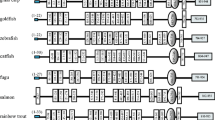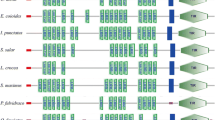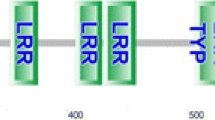Abstract
We cloned the cDNAs and genes of two different types of toll-like receptors from Japanese flounder. The results of homology searches suggested that these genes (designated JF-TLR2 and JF-TLR22) are homologues of human TLR2 and fugu TLR22, respectively. The cDNAs of JF-TLR2 and JF-TLR22 encoded 818 and 961 amino acid residues, respectively. JF-TLR2 and JF-TLR22 contained two distinct structural/functional motifs of the TLR family, such as a leucine-rich repeat (LRR) domain in the extracellular portion and a toll/interleukin-1 receptor (TIR) domain in the intracellular portion. The genes of JF-TLR2 and JF-TLR22 consisted of 12 exons (4.9 kb in total length) and four exons (4.3 kb in total length), respectively. The first exon of each gene is a non-coding exon. Southern blot hybridization indicated that both JF-TLR2 and JF-TLR22 exist as single copies in the genome. These genes were mainly expressed in peripheral blood leukocytes (PBLs) and weakly expressed in PBL-rich organs such as kidney, spleen and gill. Expression of these genes was induced by both peptidoglycan and polyI:C, although the number of JF-TLR-expressing cells were not changed after induction. All of these results suggest that they are involved in the innate immune system.









Similar content being viewed by others
References
Akira S, Hemmi H (2003) Recognition of pathogen-associated molecular patterns by TLR family. Immunol Lett 85:85–95
Alexopoulou L, Holt AC, Medzhitov R, Flavell RA (2001) Recognition of double-stranded RNA and activation of NF-kappaB by Toll-like receptor 3. Nature 413:732–738
Aliprantis AO, Yang RB, Mark MR, Suggett S, Devaux B, Radolf JD, Klimpel GR, Godowski P, Zychlinsky A (1999) Cell activation and apoptosis by bacterial lipoproteins through toll-like receptor-2. Science 285:736–739
Aparicio S, Chapman J, Stupka E, Putnam N, Chia JM, Dehal P, Christoffels A, Rash S, Hoon S, Smit A, Gelpke MD, Roach J, Oh T, Ho IY, Wong M, Detter C, Verhoef F, Predki P, Tay A, Lucas S, Richardson P, Smith SF, Clark MS, Edwards YJ, Doggett N, Zharkikh A, Tavtigian SV, Pruss D, Barnstead M, Evans C, Baden H, Powell J, Glusman G, Rowen L, Hood L, Tan YH, Elgar G, Hawkins T, Venkatesh B, Rokhsar D, Brenner S (2002) Whole-genome shotgun assembly and analysis of the genome of Fugu rubripes. Science 297:1301–1310
Belvin MP, Anderson KV (1996) A conserved signaling pathway: the Drosophila toll-dorsal pathway. Annu Rev Cell Dev Biol 12:393–416
Brightbill HD, Libraty DH, Krutzik SR, Yang RB, Belisle JT, Bleharski JR, Maitland M, Norgard MV, Plevy SE, Smale ST, Brennan PJ, Bloom BR, Godowski PJ, Modlin RL (1999) Host defense mechanisms triggered by microbial lipoproteins through toll-like receptors. Science 285:732–736
Flo TH, Ryan L, Latz E, Takeuchi O, Monks BG, Lien E, Halaas O, Akira S, Skjak-Braek G, Golenbock DT, Espevik (2002) Involvement of toll-like receptor (TLR) 2 and TLR4 in cell activation by mannuronic acid polymers. J Biol Chem 277:35489–35495
Hajjar AM, O’Mahony DS, Ozinsky A, Underhill DM, Aderem A, Klebanoff SJ, Wilson CB (2001) Functional interactions between toll-like receptor (TLR) 2 and TLR1 or TLR6 in response to phenol-soluble modulin. J Immunol 166:15–19
Hayashi F, Smith KD, Ozinsky A, Hawn TR, Yi EC, Goodlett DR, Eng JK, Akira S, Underhill DM, Aderem A (2001) The innate immune response to bacterial flagellin is mediated by Toll-like receptor 5. Nature 410:1099–1103
Hemmi H, Takeuchi O, Kawai T, Kaisho T, Sato S, Sanjo H, Matsumoto M, Hoshino K, Wagner H, Takeda K, Akira S (2000) A Toll-like receptor recognizes bacterial DNA. Nature 408:740–745
Hemmi H, Kaisho T, Takeuchi O, Sato S, Sanjo H, Hoshino K, Horiuchi T, Tomizawa H, Takeda K, Akira S (2002) Small anti-viral compounds activate immune cells via the TLR7 MyD88-dependent signaling pathway. Nat Immunol 3:196–200
Hirono I, Nam BH, Kurobe T, Aoki T (2000) Molecular cloning, characterization, and expression of TNF cDNA and gene from Japanese flounder Paralichthys olivaceus. J Immunol 165:4423–4427
Jurk M, Heil F, Vollmer J, Schetter C, Krieg AM, Wagner H, Lipford G, Bauer S (2002) Human TLR7 or TLR8 independently confer responsiveness to the antiviral compound R-848. Nat Immunol 3:499
Katagiri T, Hirono I, Aoki T (1998) Identification of a cDNA for medaka cytoskeletal β-actin and construction for the reverse transcriptase-polymerase chain reaction (RT-PCR) primers. Fisheries Science 63:73–76
Katagiri T, Asakawa S, Hirono I, Aoki T, Shimizu N (2000)Genomic bacterial artificial chromosome library of the Japanese flounder Paralichthys olivaceus. Marine Biotechnol 2:571–576
Kurt-Jones EA, Popova L, Kwinn L, Haynes LM, Jones LP, Tripp RA, Walsh EE, Freeman MW, Golenbock DT, Anderson LJ, Finberg RW (2000) Pattern recognition receptors TLR4 and CD14 mediate response to respiratory syncytial virus. Nat Immunol 1:398–401
Lee JY, Hirono I, Aoki T (2000) Cloning and analysis of expression of Mx cDNA in Japanese flounder, Paralichthys olivaceus. Dev Comp Immunol 24:407–415
Lemaitre B, Nicolas E, Michaut L, Reichhart JM, Hoffmann JA (1996) The dorsoventral regulatory gene cassette spatzle/Toll/cactus controls the potent antifungal response in Drosophila adults. Cell 86:973–83
Means TK, Lien E, Yoshimura A, Wang S, Golenbock DT, Fenton MJ (1999) The CD14 ligands lipoarabinomannan and lipopolysaccharide differ in their requirement for Toll-like receptors. J Immunol 163:6748–6755
Means TK, Jones BW, Schromm AB, Shurtleff BA, Smith JA, Keane J, Golenbock DT, Vogel SN, Fenton MJ (2001) Differential effects of a Toll-like receptor antagonist on Mycobacterium tuberculosis-induced macrophage responses. J Immunol 166:4074–4082
Medzhitov R (2001) Toll-like receptors and innate immunity. Nat Rev Immunol 1:135-145
Medzhitov R, Janeway CA Jr (1997) Innate immunity: the virtues of a nonclonal system of recognition. Cell 91:295–298
Nam BH, Hirono I, Aoki T (2003) Bulk isolation of immune response-related genes by expressed sequenced tags of Japanese flounder Paralichthys olivaceus leucocytes stimulated with Con A/PMA. Fish Shellfish Immunol 14:467-476
Ohashi K, Burkart V, Flohe S, Kolb H (2000) Cutting edge: heat shock protein 60 is a putative endogenous ligand of the toll-like receptor-4 complex. J Immunol 164:558–561
Oshiumi H, Tsujita T, Shida K, Matsumoto M, Ikeo K, Seya T (2003) Prediction of the prototype of the human Toll-like receptor gene family from the pufferfish, Fugu rubripes, genome. Immunogenetics 54:791–800
Park CI, Hirono I, Enomoto J, Nam BH, Aoki T (2001) Cloning of Japanese flounder Paralichthys olivaceus CD3 cDNA and gene, and analysis of its expression. Immunogenetics 53:130–135
Poltorak A, Ricciardi-Castagnoli P, Citterio S, Beutler B (2000) Physical contact between lipopolysaccharide and toll-like receptor 4 revealed by genetic complementation. Proc Natl Acad Sci USA 97:2163–2167
Schwandner R, Dziarski R, Wesche H, Rothe M, Kirschning CJ (1999) Peptidoglycan- and lipoteichoic acid-induced cell activation is mediated by toll-like receptor 2. J Biol Chem 274:17406–17409
Stafford JL, Ellestad KK, Magor KE, Belosevic M, Magor BG (2003) A toll-like receptor (TLR) gene that is up-regulated in activated goldfish macrophages. Dev Comp Immunol 27:685–698
Takeuchi O, Akira S (2001) Toll-like receptors; their physiological role and signal transduction system. Int Immunopharmacol 1:625–635
Underhill DM, Ozinsky A, Hajjar AM, Stevens A, Wilson CB, Bassetti M, Aderem A (1999) The Toll-like receptor 2 is recruited to macrophage phagosomes and discriminates between pathogens. Nature 401:811–815
Vabulas RM, Ahmad-Nejad P, da Costa C, Miethke T, Kirschning CJ, Hacker H, Wagner H (2001) Endocytosed HSP60s use toll-like receptor 2 (TLR2) and TLR4 to activate the toll/interleukin-1 receptor signaling pathway in innate immune cells. J Biol Chem 276:31332–31339
Wagner H (2002) Interactions between bacterial CpG-DNA and TLR9 bridge innate and adaptive immunity. Curr Opin Microbiol 5:62–69
Yamamoto E (1999) Studies on sex-manipulation and production of cloned populations in hirame flounder, Paralichthys olivaceus (Temminck et Schlegel). Aquaculture 173:235–246
Zarember KA, Godowski PJ (2002) Tissue expression of human Toll-like receptors and differential regulation of Toll-like receptor mRNAs in leukocytes in response to microbes, their products, and cytokines. J Immunol 168:554–561
Acknowledgements
This research was supported in part by a Grant-in-Aid for Scientific Research (S) (no. 15108003) from the Japanese Ministry of Education, Science, Culture, and Sports.
Author information
Authors and Affiliations
Corresponding author
Rights and permissions
About this article
Cite this article
Hirono, I., Takami, M., Miyata, M. et al. Characterization of gene structure and expression of two toll-like receptors from Japanese flounder, Paralichthys olivaceus . Immunogenetics 56, 38–46 (2004). https://doi.org/10.1007/s00251-004-0657-2
Received:
Revised:
Published:
Issue Date:
DOI: https://doi.org/10.1007/s00251-004-0657-2




